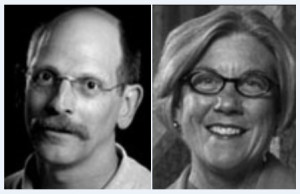Journalists Share Experiences, Tips on How to Report on Disease
A Photographic Exhibit on Leprosy, ‘Carville: No Place for Cowards,’ Is Now on Display at the McDougall Center
By Ashley Szatala
Columbia, Mo. (Nov. 23, 2015) — Mark Petty, BJ ’75, was on assignment for The Pensacola (Florida) News Journal to do a quick story about patients at a leprosy hospital in Carville, Louisiana. Upon leaving the hospital, Petty couldn’t get the scenes he saw out of his mind. The disease feared since Biblical times fascinated Petty and moved him to tears.

Petty quit his job. His wife, Marty, BJ ’75, quit hers, too, and together they moved to the leprosy hospital for 18 months to do a documentary project on the patients there.
Leprosy, now known as Hansen’s disease, was once a most feared and mysterious disease. Millions suffered from the incurable infectious disease that caused disfigurement. Hansen’s disease can now be treated with drug therapy.
The U.S. Public Health Service Hospital in Carville was founded in the 1890s to house those with leprosy. It closed in 1999.
Mark Petty gifted a 43-print set of his photographs to the Missouri School of Journalism in March. The couple hand-printed 16×20 silver prints of archival quality. In addition to retaining the collection in the archive, an exhibit of the work was mounted and presented in the gallery of the McDougall Center for Photojournalism Studies, located on the ground floor of Lee Hills Hall.

The exhibit, “Carville: No Place for Cowards,” is now installed in the McDougall Center. Also included in the display are video interviews produced by Hany Hawasly, MA ’14, that documents the couple’s recollection of the experience. The exhibit will be on display until Jan. 29, 2016. It is free and open to the public.
“It was a fantastic opportunity to display their work,” said David Rees, professor and director of the McDougall Center. “It’s never been published or seen before.”
On Nov. 4, Mark and Marty Petty visited the Missouri School of Journalism to discuss what it was like to document those afflicted with Hansen’s disease.
Gaining trust was key, the Pettys told the students. They found that their best strategy while in Carville was to spend time with patients, touch them, show no fear of becoming infected with Hansen’s disease, and see those afflicted as people rather than patients who are disfigured.
A reception was held to honor Mark and Marty Petty as well as to welcome health care reporters Blythe Bernhard and Rob Logan, MA ’73.

Bernhard, of the St. Louis Post-Dispatch, and Logan, who works at the National Library of Medicine, presented ways to cover health stories and balance the public’s right to know information with the pleas of public health officials to not alarm the public. Their discussion, “Covering Disease: The Journalist’s Challenge,” was led by Len Bruzzese, executive director of the Association of Health Care Journalists.
Bringing the four journalists to MU was a collaborative effort by the McDougall Center, Pictures of the Year International, the University of Missouri‘s Master of Public Health (MPH) program and the Association of Health Care Journalists, which is celebrating its 10th anniversary at the journalism school.
In addition to Mark and Marty Petty’s work being shown in the McDougall Center, “The Human Face of Disease,” a collection of photographs from the Pictures of the Year International archives, is being shown in the lobby of the Donald W. Reynolds Journalism Institute. As the majority of emerging infectious diseases are zoonotic (transmitted from animals to humans), Missouri students studying public health worked with organizers of the exhibit to illuminate the important connections between animal and human health. MU MPH candidates from around the world worked in teams to research the non-human face of Malaria, Hansen’s disease, HIV, Ebola and tuberculosis and present that information in panels alongside the photographs.
Updated: September 14, 2020